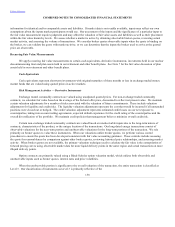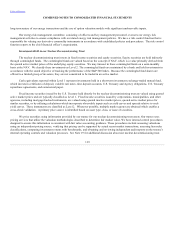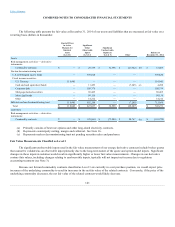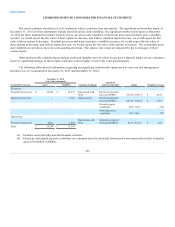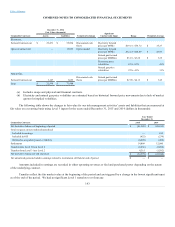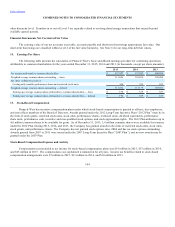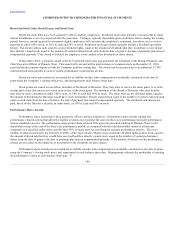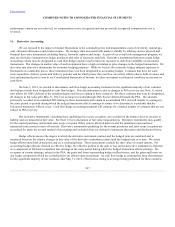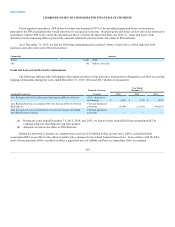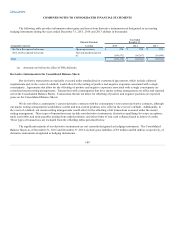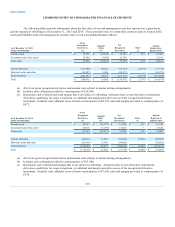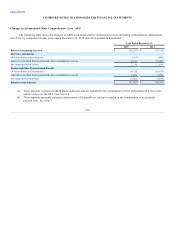APS 2015 Annual Report Download - page 152
Download and view the complete annual report
Please find page 152 of the 2015 APS annual report below. You can navigate through the pages in the report by either clicking on the pages listed below, or by using the keyword search tool below to find specific information within the annual report.
Table of Contents
COMBINED NOTES TO CONSOLIDATED FINANCIAL STATEMENTS
performance criteria are not achieved, no compensation cost is recognized and any previously recognized compensation cost is
reversed.
16. Derivative Accounting
We are exposed to the impact of market fluctuations in the commodity price and transportation costs of electricity, natural gas,
coal, emissions allowances and in interest rates. We manage risks associated with market volatility by utilizing various physical and
financial derivative instruments, including futures, forwards, options and swaps. As part of our overall risk management program, we
may use derivative instruments to hedge purchases and sales of electricity and fuels. Derivative instruments that meet certain hedge
accounting criteria may be designated as cash flow hedges and are used to limit our exposure to cash flow variability on forecasted
transactions. The changes in market value of such instruments have a high correlation to price changes in the hedged transactions. We
also enter into derivative instruments for economic hedging purposes. While we believe the economic hedges mitigate exposure to
fluctuations in commodity prices, these instruments have not been designated as accounting hedges. Contracts that have the same
terms (quantities, delivery points and delivery periods) and for which power does not flow are netted, which reduces both revenues and
fuel and purchased power costs in our Consolidated Statements of Income, but does not impact our financial condition, net income or
cash flows.
On June 1, 2012, we elected to discontinue cash flow hedge accounting treatment for the significant majority of our contracts
that had previously been designated as cash flow hedges. This discontinuation is due to changes in PSA recovery (see Note 3), which
now allows for 100% deferral of the unrealized gains and losses relating to these contracts. For those contracts that were de-designated,
all changes in fair value after May 31, 2012 are no longer recorded through OCI, but are deferred through the PSA. The amounts
previously recorded in accumulated OCI relating to these instruments will remain in accumulated OCI, and will transfer to earnings in
the same period or periods during which the hedged transaction affects earnings or sooner if we determine it is probable that the
forecasted transaction will not occur. Cash flow hedge accounting treatment will continue for a limited number of contracts that are not
subject to PSA recovery.
Our derivative instruments, excluding those qualifying for a scope exception, are recorded on the balance sheet as an asset or
liability and are measured at fair value. See Note 13 for a discussion of fair value measurements. Derivative instruments may qualify
for the normal purchases and normal sales scope exception if they require physical delivery and the quantities represent those
transacted in the normal course of business. Derivative instruments qualifying for the normal purchases and sales scope exception are
accounted for under the accrual method of accounting and excluded from our derivative instrument discussion and disclosures below.
Hedge effectiveness is the degree to which the derivative instrument contract and the hedged item are correlated and is
measured based on the relative changes in fair value of the derivative instrument contract and the hedged item over time. We assess
hedge effectiveness both at inception and on a continuing basis. These assessments exclude the time value of certain options. For
accounting hedges that are deemed an effective hedge, the effective portion of the gain or loss on the derivative instrument is reported
as a component of OCI and reclassified into earnings in the same period during which the hedged transaction affects earnings. We
recognize in current earnings, subject to the PSA, the gains and losses representing hedge ineffectiveness, and the gains and losses on
any hedge components which are excluded from our effectiveness assessment. As cash flow hedge accounting has been discontinued
for the significant majority of our contracts, after May 31, 2012, effectiveness testing is no longer being performed for these contracts.
147



